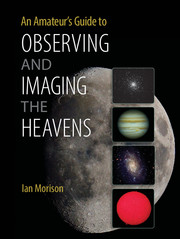Book contents
- Frontmatter
- Dedication
- Contents
- Preface
- Acknowledgements
- Prologue A Tale of Two Scopes
- 1 Telescope and Observing Fundamentals
- 2 Refractors
- 3 Binoculars and Spotting Scopes
- 4 The Newtonian Telescope and Its Derivatives
- 5 The Cassegrain Telescope and Its Derivatives
- 6 Telescope Maintenance, Collimation and Star Testing
- 7 Telescope Accessories
- 8 Telescope Mounts
- 9 The Art of Visual Observing
- 10 Visual Observations of the Moon and Planets
- 11 Imaging the Moon and Planets
- 12 Observing and Imaging the Sun
- 13 Observing and Imaging with an Astro-Video Camera
- 14 DSLR Deep-Sky Imaging
- 15 Imaging with Cooled CCD Cameras
- 16 Auto-Guiding and Drift Scan Alignment
- 17 Spectral Studies
- 18 Improving and Enhancing Images in Photoshop
- Index
- Plate Section
5 - The Cassegrain Telescope and Its Derivatives
Schmidt-Cassegrains and Maksutovs
Published online by Cambridge University Press: 05 June 2014
- Frontmatter
- Dedication
- Contents
- Preface
- Acknowledgements
- Prologue A Tale of Two Scopes
- 1 Telescope and Observing Fundamentals
- 2 Refractors
- 3 Binoculars and Spotting Scopes
- 4 The Newtonian Telescope and Its Derivatives
- 5 The Cassegrain Telescope and Its Derivatives
- 6 Telescope Maintenance, Collimation and Star Testing
- 7 Telescope Accessories
- 8 Telescope Mounts
- 9 The Art of Visual Observing
- 10 Visual Observations of the Moon and Planets
- 11 Imaging the Moon and Planets
- 12 Observing and Imaging the Sun
- 13 Observing and Imaging with an Astro-Video Camera
- 14 DSLR Deep-Sky Imaging
- 15 Imaging with Cooled CCD Cameras
- 16 Auto-Guiding and Drift Scan Alignment
- 17 Spectral Studies
- 18 Improving and Enhancing Images in Photoshop
- Index
- Plate Section
Summary
The classical Cassegrain telescope utilises a parabolic primary mirror and a small, convex, hyperbolic secondary mirror inside the focus of the primary which directs the light cone through a central aperture in the primary to a focal point beyond. Such a configuration is ideal for large telescopes, as the often-heavy instrumentation is located where the major weight of the telescope lies. As the light path is folded within the telescope tube, the instrument is quite short in relation to its focal length. The convex secondary mirror multiplies the focal length by what is termed the ‘secondary magnification’, M, which is the focal length of the system divided by the focal length of the primary. One result of a configuration with a high secondary magnification (to yield a compact system) is to give significant curvature of field.
A Planetary Cassegrain
Relatively few pure Cassegrain telescopes are in use by amateur astronomers; variants of the design, described later, are far more popular. However, one pure Cassegrain has recently come onto the market aimed specifically at planetary observing and imaging which could, perhaps, give these telescopes a little more prominence. The obvious design aim would be to make the secondary mirror as small as possible, and this is achieved by having a primary mirror of higher focal ratio than normal and hence a secondary mirror with a smaller magnification ratio. The telescope would thus be longer than a typical Cassegrain.
- Type
- Chapter
- Information
- An Amateur's Guide to Observing and Imaging the Heavens , pp. 74 - 85Publisher: Cambridge University PressPrint publication year: 2014



